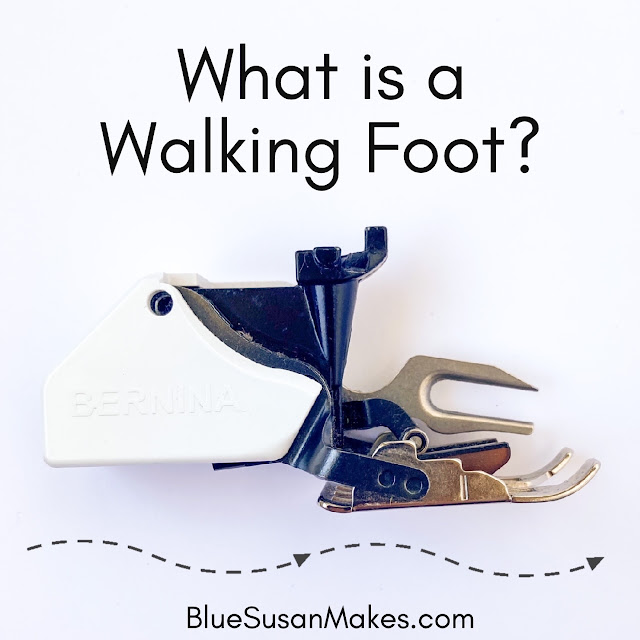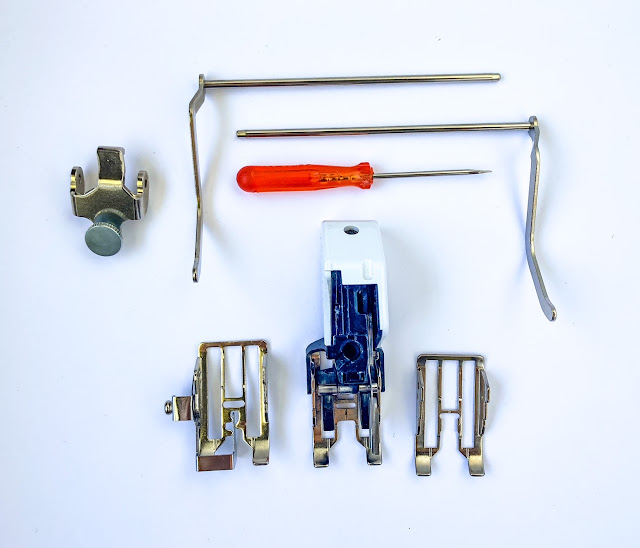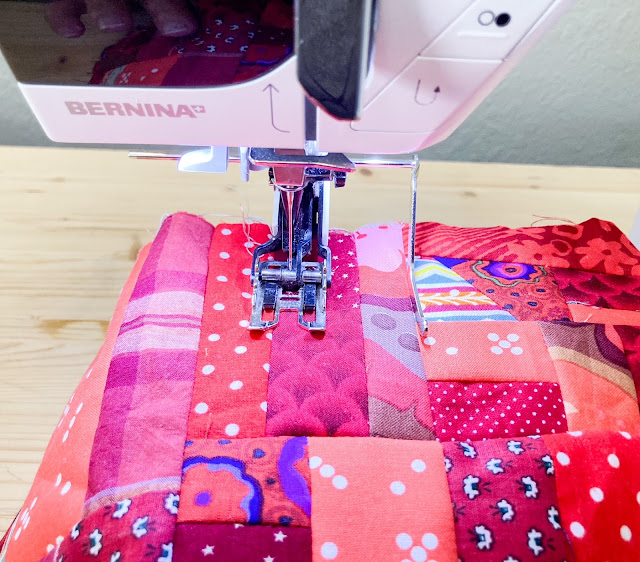Do you use a Walking Foot when you sew? If not, I'm here to tell you it will up your sewing game and reduce frustration if you make quilts or handbags. Come learn all about how, why, and when to use a Walking Foot.
But first lets talk about "feed dogs". All sewing machines have a set of 'feed dogs' - the metal teeth that sit directly below the presser foot of the machine. The 'feed dogs' move back and forth to grab the fabric from below to advance it through the machine as you sew.
What is a Walking Foot?
A walking foot, also called a dual feed or even feed presser foot, is a sewing machine foot attachment that has an additional set of feed dogs to advance the fabric from above. This allows the set of fabrics to feed evenly through the machine and prevents the fabrics from shifting as you sew. The #50 Bernina Walking Foot pictured below (the one I have for my machine) has a set of rubber feed dogs that grab the fabric at the same time as the lower metal feed dogs.
Another type of Walking Foot
How does a Walking Foot work?
The set extra 'feed dogs' on a walking foot works together with the feed dogs built into a sewing machine to create a dual feeding action that allows all the layers of a fabric stack to be pulled through the machine at the same time. This allows for fabrics to match up more evenly as you sew.
This is especially important if you are sewing multiple layers together or if the layers are thick, as in sewing a 'quilt sandwich' or handbags with multiple layers of interfacing. If you sew quilts or handbags a walking foot is a must.
Do I really need a walking foot?
If you only occasionally sew home decor items or mend clothing pieces you may not need to invest in a walking foot. But if you sew regularly, or make quilts or handbags, getting a walking foot is a must. A walking foot dramatically improves your sewing experience. It makes sewing so much less frustrating and makes it feel like your project outcome is easier to control. I almost never take my walking foot off the machine, I love it so much. When I do take it off to use a zipper foot I am reminded why I the walking foot is so invaluable.
Walking foot seam comparison.
Here is an example of the difference a walking foot can make when sewing a little quilt sandwich (fabric-batting-fabric). In the photo below these 2 seams are sewn in the same direction from top to bottom. The fabrics were stacked evenly before I started sewing.
The left seam is sewn with a walking foot and you can see there was very minimal shifting. The fabrics are sewn together evenly with no extra effort on my part. The seam on the right was sewn with my regular presser foot. By the time I finished sewing the seam, the top and bottom no longer match up exactly. It is quite a dramatic difference.
If you don't have a walking foot you can try to combat this problem a little adding a little pressure from above to help push the fabric through but I think that is a pain and doesn't always help. This fabric shifting especially happens for me when I use a zipper foot. The zipper foot my machine comes with is so narrow and doesn't seem to help control the feed of the sewing at all. It is really frustrating.
When to not use a Walking foot.
In my sewing experience the ONLY time I would suggest not using a walking foot is if you are sewing a zipper, using the fancy embroidery stitches your machine, or free motion quilting. Otherwise you can leave it on and sew with just about anything else. It makes sewing with all types of fabric easier.
Bernina #50 3 Sole Walking Foot with extra Sew guides
I bought this Walking foot when I got my Bernina 350E.?? I previously had a Pfaff machine and was so used to using the dual feed foot I couldn't live without it. The Bernina #50 Walking Foot comes with an open toe foot and a 'stitch in the ditch' foot. It also comes with sew guides that come in really handy when you are quilting a project.
I hope this information was helpful. I love sharing my sewing knowledge with you. If you like this post, please share it with a friend, or 'pin' it for later. Connect with me on Facebook or Instagram.
Do you sew with a walking foot?
I love to hear from you. Leave a comment below and let me know your experience with a walking foot. What other helpful information am I missing?
Love to sew? Check out these handmade gifts ideas...










No comments:
Post a Comment